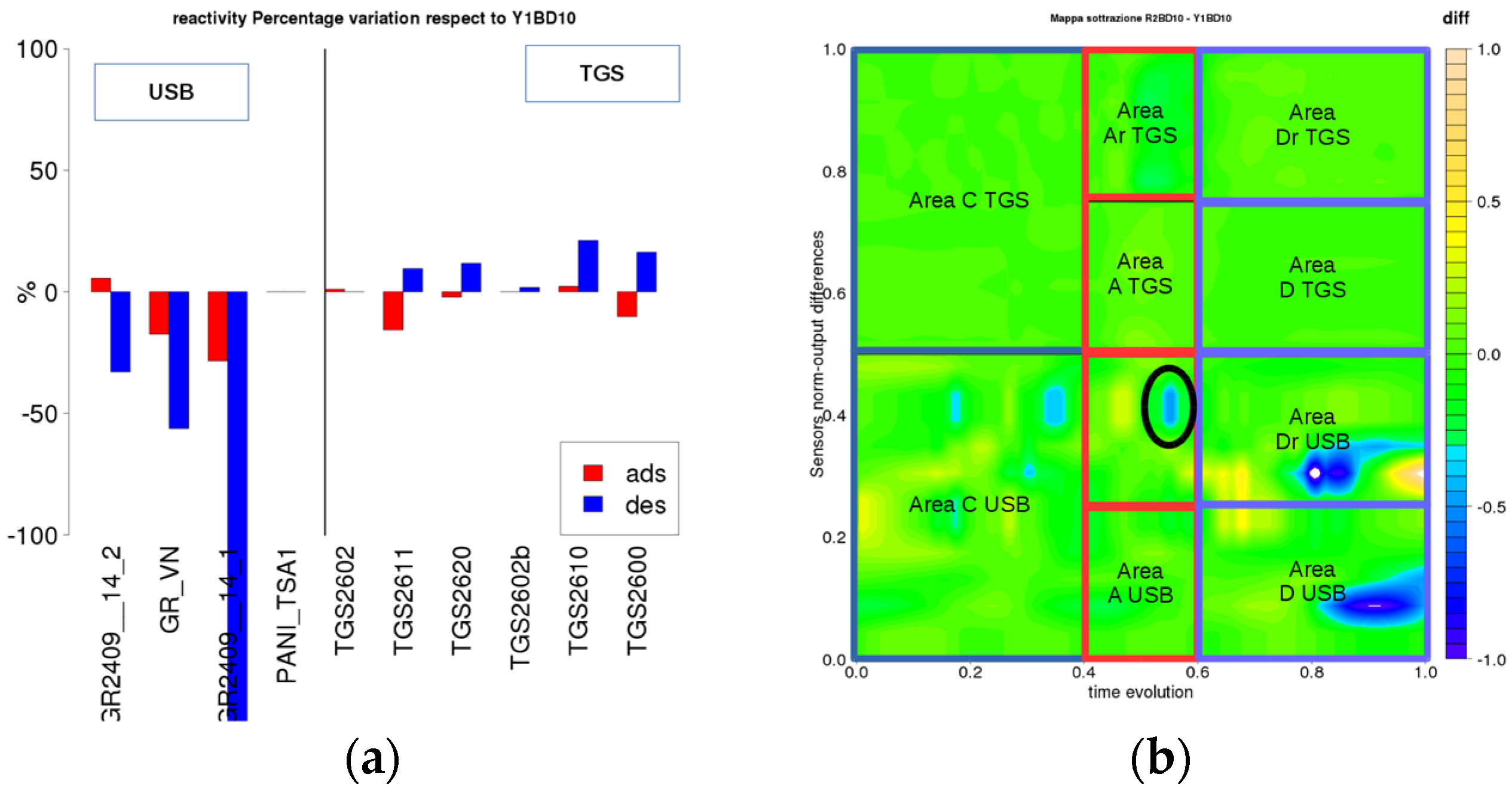Chili Pepper Scent: Study and Recognition with Chemiresistors Array †
Abstract
:1. Introduction
2. Materials and Methods
2.1. Analytical Method
2.2. E-Nose Method
- for the Sensor j baseline R0_j is calculated taking into account the mean value of 30 sampling before odour injection;
- percentage relative response: Rsp_j = max|R_ij-R0_j|)/R0_j*100;
- relative response velocity (signal differential with sampling at 1 Hz): Vrsp_ij = (R_ij − R_(I − 1)j)/R0_j;
- max relative response velocity: MVrsp_j = max|R_ij − R_(i − 1)j|/R0_j. This parameter can be calculated both during the odour inhaling phase (ads) that during the odour exhaling phase (des);
- a new homogenized matrix S_ij (20 × 150) composed by (Rsp_j − R_ij)/Rsp_j for j = 1:10 and Vrsp_ij/MVrsp_j for j = 11:20;
- Taking into account the USB Sensor that give the best MVrsp and the TGS Sensor that give the Best Mvrsp we calculate RMVrsp_j as the ratio of the MVrsp to the best one for each Sensor family.
3. Results and Discussion
3.1. Chili Pepper Scent Chemical Composition
3.2. E-Nose Odour Comparison between Habanero and Fatalii
4. Conclusions
Acknowledgments
Conflicts of Interest
References
- Peris, M.; Escuder-Gilabert, L. Electronic noses and tongues to assess food authenticity and adulteration. Trends Food Sci. Technol. 2016, 58, 40–54. [Google Scholar] [CrossRef]
- Sberveglieri, V. Validation of Parmigiano Reggiano Cheese Aroma Authenticity, Categorized through the Use of an Array of Semiconductors Nanowire Device (S3). Materials 2016, 9, 81. [Google Scholar] [CrossRef] [PubMed]
- Gliszczyńska-Świgło, A.; Chmielewski, J. Electronic Nose as a Tool for Monitoring the Authenticity of Food. A Review. Food Anal. Methods 2017, 10, 1800–1806. [Google Scholar] [CrossRef]
- Sberveglieri, V.; Comini, E.; Zappa, D.; Pulvirenti, A.; Núñez Carmona, E. Electronic nose for the early detection of different types of indigenous mold contamination in green coffee. In Proceedings of the Seventh International Conference on Sensing Technology (ICST), Wellington, New Zealand, 3–5 December 2013; pp. 461–465. [Google Scholar]
- Pruthi, J.S. Spices and Condiments; Chichester, E.M., Stewart, G.F., Eds.; Spices and Condiments; Academic Press: New York, NY, USA, 1980; p. 13. [Google Scholar]
- Núñez Carmona, E.; Sberveglieri, V.; Ponzoni, A.; Zappa, D.; Pulvirenti, A. Detection of microbial contamination in potable water by Nanowire technology. In Proceedings of the 8th International Conference on Sensing Technology (ICST), Liverpool, UK, 2–4 September 2014; pp. 136–139. [Google Scholar]
- Massera, E.; de Vito, S.; Formisano, F.; Buonanno, A.; Alfano, B.; di Francia, G.; Veneri, P.D. SNIFFI: A Portable development Gas Sensing embedded System. In Proceedings of the 2015 XVIII AISEM Annual Conference, Trento, Italy, 3–5 February 2015; pp. 1–4. [Google Scholar]
- Ricciardella, F.; Massera, E.; Polichetti, T.; Miglietta, M.L.; Di Francia, G. A calibrated graphene-based chemi-sensor for sub parts-per-million NO2 detection operating at room temperature. Appl. Phys. Lett. 2014, 104, 183502. [Google Scholar] [CrossRef]
- Kira, K.; Rendell, L.A. A Practical Approach to Feature Selection. In Proceedings of the Ninth International Workshop on Machine Learning, 1992; pp. 249–256. [Google Scholar]

© 2017 by the authors. Licensee MDPI, Basel, Switzerland. This article is an open access article distributed under the terms and conditions of the Creative Commons Attribution (CC BY) license (https://creativecommons.org/licenses/by/4.0/).
Share and Cite
Massera, E.; Sberveglieri, V.; Núñez-Carmona, E.; Vito, S.D.; Galstyan, V.; Zappa, D.; Miglietta, M.L.; Alfano, B.; Francia, G.D. Chili Pepper Scent: Study and Recognition with Chemiresistors Array. Proceedings 2017, 1, 597. https://doi.org/10.3390/proceedings1040597
Massera E, Sberveglieri V, Núñez-Carmona E, Vito SD, Galstyan V, Zappa D, Miglietta ML, Alfano B, Francia GD. Chili Pepper Scent: Study and Recognition with Chemiresistors Array. Proceedings. 2017; 1(4):597. https://doi.org/10.3390/proceedings1040597
Chicago/Turabian StyleMassera, Ettore, Veronica Sberveglieri, Estefania Núñez-Carmona, Saverio De Vito, Vardan Galstyan, Dario Zappa, Maria Lucia Miglietta, Brigida Alfano, and Girolamo Di Francia. 2017. "Chili Pepper Scent: Study and Recognition with Chemiresistors Array" Proceedings 1, no. 4: 597. https://doi.org/10.3390/proceedings1040597








